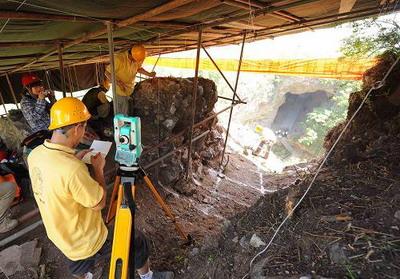
Archeologist conducting a rescue excavation in the Zhoukoudian Caves (Picture by Luo Xiaoguang)
China Wednesday began a rescue excavation in the Zhoukoudian Caves in a suburb of Beijing, where the skulls of "Peking Man," or Homo erectus, were found in the 1920s and 1930s.
The following is a chronology of excavation and finds at the site:
In February 1918, Johann Gunnar Andersson, a famous Swedish geologist and archaeologist, made a survey at the hill near Zhoukoudian, which was then called "Chicken Bone Hill", and colleted numerous rodent fossils. These fossils had been mistaken by local people for chicken bones, giving rise to the name of the hill. The site was later designated as Locality 6 of the "Peking Man" site. This survey inspired further expeditions.
Between 1921 and 1922, Andersson and Otto Zdansky, an Austrian paleontologist, started an excavation at another hill near Zhoukoudian. They found two human-like teeth, an upper molar and an unerupted lower premolar. These finds surprised scientists, since at that time, no such ancient human fossil had been found anywhere in Asia.
In 1921, Davidson Black, a Canadian anthropologist, studied the upper molar. He classified the specimen under Hominidae, a new genus, and a new species, "Sinanthropus pekinensis Black and Zdansky". An American geologist, William Grabau, gave it the popular name "Peking Man".
Weng Wenhao, the director of the Geological Survey of China, and Black started a research program at the site in February 1927.The systematic excavation of the Zhoukoudian Site began thereafter.
In 1928, C. C. Young, a famous Chinese paleontologist, and Pei Wenzhong, a young Chinese geologist, joined the excavation. Two lower jaws of "Peking Man" were unearthed in this year.
The most important discovery of all occurred on Dec. 2, 1929. Pei found the first, and almost complete, skull cap of "Peking Man" in the red sandy clay in a branching cave where a fissure crosses the main cave.
In 1930, the second skull was discovered in the spring. It was found and restored from a block of sediment near where the first skullcap was found.
In 1932, the scale of the excavation was large, with more than 100 workers a day at the site.
The most fruitful year was 1936, when three complete skullcaps were unearthed by Jia Lanpo, then a technician and later a world famous archaeologist.
The excavation ended in 1937 when the Japanese army invaded China. After the war, parts of another skull were found in 1966. (Xinhua)
Related News
Photos
More>>trade
- CAS Researcher Publishes Book on Marine Biogeochemistry in China Marginal Seas
- SCBG Conducts International Strategic Review and Designs for the Future
- AMS02 to Lift off Next July
- CAS President Gives Speech at Fourth World Science Forum
- Sino-German Cooperation Makes Big Progress on Novel SQUID/electronics
market
finance
- AMS Experiment Embarks on First Leg of Mission into Space
- New Finding Confirms the Link between Dinosaurs and Birds
- China Unearthed Oldest Known Ancestor of Birds
- IMHE and Chongqing University Sign Science and Technology Strategic Cooperation
- CAS Vice President Inspects CSNS and Daya Bay Reactor Neutrino Experiment





